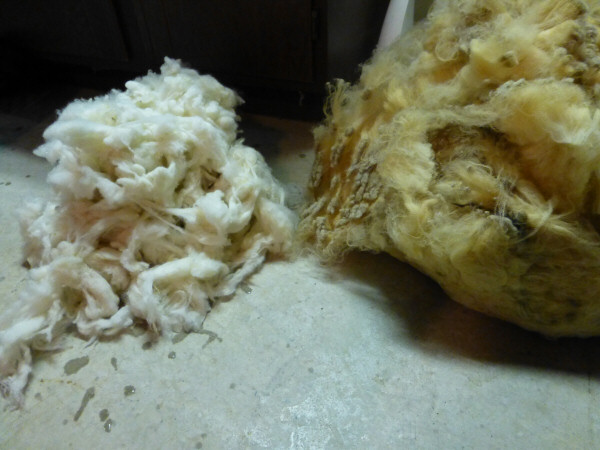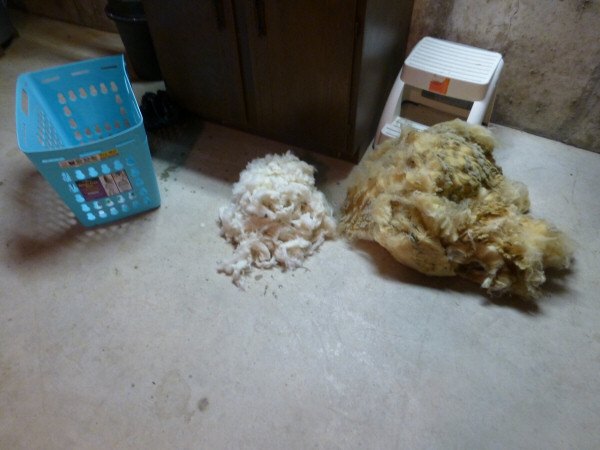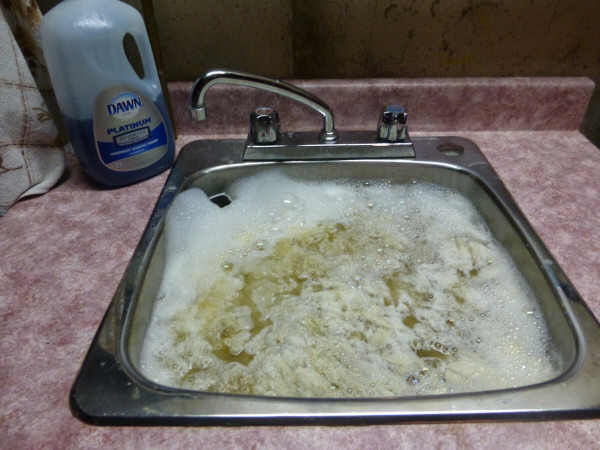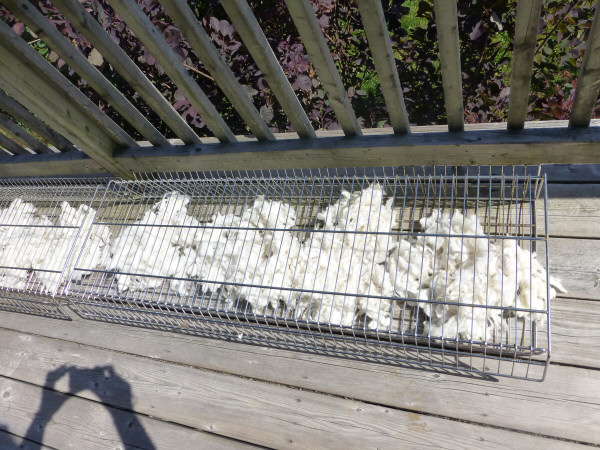

I have talked at length about the fact that most of my yarn is made from the ground up. The only thing I do not own (yet anyway) is the sheep, rabbits, goats or alpaca the fiber comes from. That’s not to say that I can pass up a nice looking roving at the Fiber festival – but I do spend the majority of my time at the Fleece sale. My main motivation in the beginning was to save money. Now, it’s mainly because I enjoy it. I love taking dirty fleece, washing it (sometimes even skirting it before hand to get rid of the poo!), carding/combing it – then dyeing it into gorgeous colors to then be blended into batts to be spun into yarn. I also enjoy meeting small producers and getting to know them, their flock, and where my fiber is coming from: something you can’t do at the yarn or craft store.
This past month I have been washing some merino fleece – from Maine – from Rivercroft farm in Starks. If you are an Easterner & spin you may know Joe & Judy Miller: I love chatting with them at the New Hampshire show, which I sadly missed this year due to a relocation. This lot was from last year’s show. I am embarrassed to say it sat around that long and some of that time in storage in fact. But that is what happens when you embark on home renos and then a move. Last year was a dud for me, as far as fleece prep is concerned.
Thankfully, these bags were already skirted – so no poo for me to remove. 🙂 I am a fleece rescuer – I drift towards the more inexpensive bags of fleece that most hand processors pass up. I see the potential in every bag. Unless it is totally full of VM (vegetable matter) or has signs of lice or fleece rot, I’m in (and I have bought duds of fleece before – live and learn). It just takes a little more elbow grease, and a little more patience.
For fleece this dirty I just reach for my bottle of Dawn dish detergent. If we were talking good quality locks or award winning fleece, I would reach for the Unicorn Power Scour or Namaste Farms Wash & Dye Bastard. But for this quality, I find Dawn works just fine. I start to fill the sink up with hot water, and while it’s filling I will place pieces of fleece to float on top. Once the top is covered, I squeeze on a bit of Dawn in a zig-zag pattern, then add another layer of fleece. Squeeze on the Dawn, and so on – until I have enough in the sink that I feel is comfortable to clean – usually about half the size of the sink. It’s fleece & soap lasagna! At this point I gently start pressing the fleece down into the water, and let soak for approximately 3 hours. This soak happens 3 times, only on the third time, I do not add soap but about a quarter of a cup of vinegar to the hot water to remove the soap residue. I usually will flip the fleece between on the 2nd and 3rd soak. If it mildly felts I don’t worry about it too much as it will be carded and then combed.

The difference in color is quite dramatic. I didn’t even realize just how yellow the unwashed fleece was until I saw it washed. Gets pretty darn white, if I don’t say so myself!
The washed fleece is run through a salad spinner to get out the excess water, then out to my deck to dry in the North Mountain air. It can get very windy here, and after chasing drying fleece all over the lawn, I have learned to put a cover on it. These racks are from a store that closed a few years ago (Zellers – for all the Canadians reading along). I would eventually like a set up so that the air can circulate both top and bottom, but for now I just flip the fleece after drying on one side for awhile – and this has worked well.
I’ve already started carding this into batts to then be dyed – and then combed into top. This is by no means a quick process but it certainly is satisfying, especially when a one of a kind skein of yarn is created.




